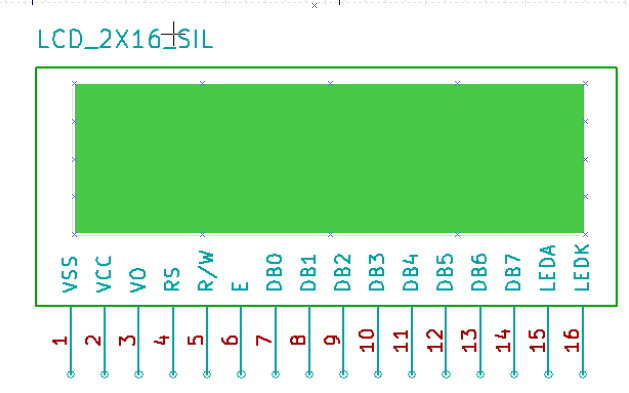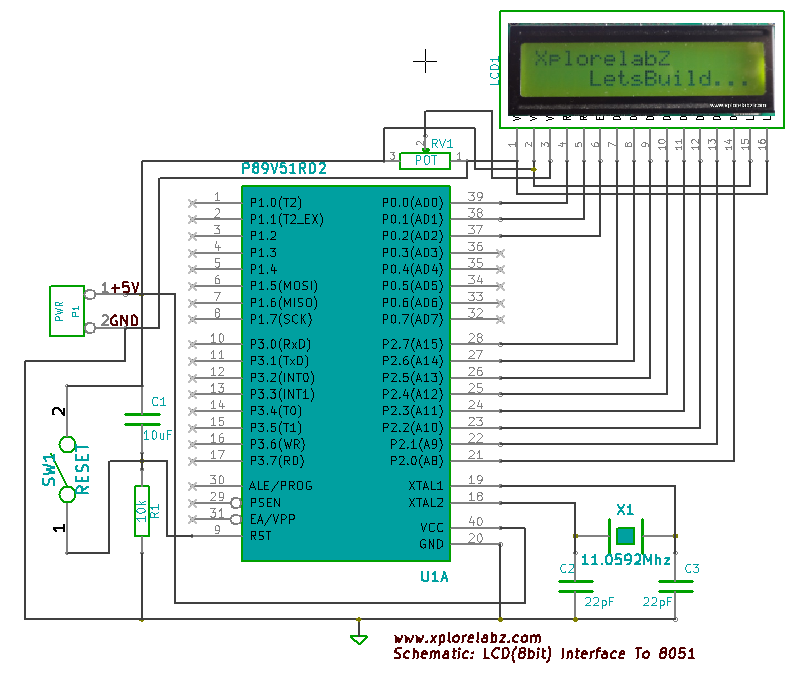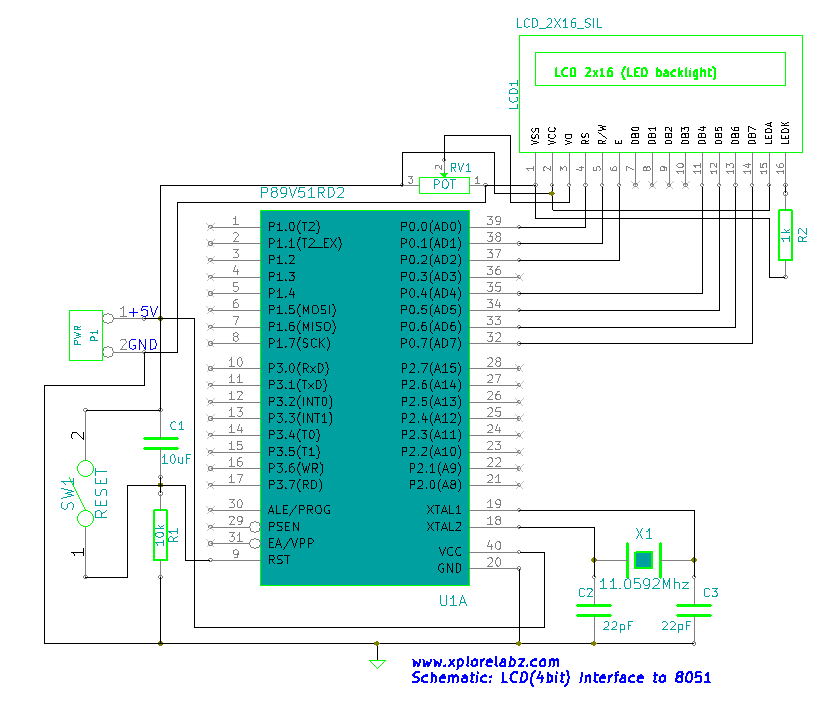Difference between revisions of "A1.8051 Interfacing:LCD 16x2"
| Line 1: | Line 1: | ||
{{Box|type=l_green_light|text=<br /> | {{Box|type=l_green_light|text=<br /> | ||
| − | + | [[File:LCD Animated Turn On.gif|right|framed|Fig2: LCD_turn_on]] | |
=Introduction:LCD= | =Introduction:LCD= | ||
Revision as of 13:12, 22 December 2013
Contents
Introduction:LCD
Liquid Crystal Display(LCDs) provide a cost effective way to put a text output unit for a microcontroller. As we have seen in the previous tutorial, LEDs or 7 Segments do no have the flexibility to display informative messages. This display has 2 lines and can display 16 characters on each line. Nonetheless, when it is interfaced with the micrcontroller, we can scroll the messages with software to display information which is more than 16 characters in length.
LCD Internal Controller
The LCD is a simple device to use but the internal details are complex. Most of the 16x2 LCDs use a Hitachi HD44780 or a compatible controller. Yes, a micrcontroller is present inside a Liquid crystal display as shown in figure 1.
The Display Controller takes commands and data from a external microcontroller and drivers the LCD panel(LCDP). It takes a ASCII value as input and generate a patter for the dot matrix. E.g., to display letter 'A', it takes its value 0X41(hex) or 65(dec) decodes it into a dot matrix of 5x8 as shown in figure 2.
Basic Commands
The LCD controller uses RS and RW lines along with E to operate the LCD.
- Resister Select (RS): Determines weather a command(RS = 0) is sent (to set up the display) or actual data(RS=1) is sent.
- Read/Write RW=0; writes to the LCD. RW=1;Reads from the LCD.
The commonly used instructions are shown in the instruction set below. Observe the Bit names: I/D, S, D, C etc at the bottom of instruction set to decode the instructions completely.
- Clear Display
- Cursor Home
- Set Entry Mode
- Display on/off control
- Cursor/display shift
- Function Set
- Read Busy Flag
- Data Read
- Data Write
Instruction Set
| Instruction | Code | Description | ||||||||||
|---|---|---|---|---|---|---|---|---|---|---|---|---|
| RS | R/W | B7 | B6 | B5 | B4 | B3 | B2 | B1 | B0 | |||
| Clear display | 0 | 0 | 0 | 0 | 0 | 0 | 0 | 0 | 0 | 1 | Clears display and returns cursor to the home position (address 0). | |
| Cursor home | 0 | 0 | 0 | 0 | 0 | 0 | 0 | 0 | 1 | * | Returns cursor to home position. Also returns display being shifted to the original position. DDRAM content remains unchanged.
| |
| Entry mode set | 0 | 0 | 0 | 0 | 0 | 0 | 0 | 1 | I/D | S | Sets cursor move direction (I/D); specifies to shift the display (S). These operations are performed during data read/write.
| |
| Display on/off control | 0 | 0 | 0 | 0 | 0 | 0 | 1 | D | C | B | Sets on/off of all display (D), cursor on/off (C), and blink of cursor position character (B).
| |
| Cursor/display shift | 0 | 0 | 0 | 0 | 0 | 1 | S/C | R/L | * | * | Sets cursor-move or display-shift (S/C), shift direction (R/L). DDRAM content remains unchanged.
| |
| Function set | 0 | 0 | 0 | 0 | 1 | DL | N | F | * | * | Sets interface data length (DL), number of display line (N), and character font (F). | |
| Read busy flag & address counter |
0 | 1 | BF | CGRAM/DDRAM address | Reads busy flag (BF) indicating internal operation being performed and reads CGRAM or DDRAM address counter contents (depending on previous instruction). | |||||||
| Write CGRAM or DDRAM |
1 | 0 | Write Data | Write data to CGRAM or DDRAM. | ||||||||
| Write CGRAM or DDRAM |
1 | 0 | Write Data | Write data to CGRAM or DDRAM. | ||||||||
| Instruction bit names — I/D - 0 = decrement cursor position, 1 = increment cursor position; S - 0 = no display shift, 1 = display shift; | ||||||||||||
LCD UNIT
 All the pins are identically to the lcd internal controller discussed above
All the pins are identically to the lcd internal controller discussed above
| PIN NUMBER | FUNCTION |
|---|---|
| 1 | Ground |
| 2 | VCC |
| 3 | Contrast adjustment (VO) |
| 4 | Register Select (RS). RS=0: Command, RS=1: Data |
| 5 | Read/Write (R/W). R/W=0: Write, R/W=1: Read |
| 6 | Clock (Enable). Falling edge triggered |
| 7 | Bit 0 (Not used in 4-bit operation) |
| 8 | Bit 1 (Not used in 4-bit operation) |
| 9 | Bit 2 (Not used in 4-bit operation) |
| 10 | Bit 3 (Not used in 4-bit operation) |
| 11 | Bit 4 |
| 12 | Bit 5 |
| 13 | Bit 6 |
| 14 | Bit 7 |
| 15 | Back-light Anode(+) |
| 16 | Back-Light Cathode(-) |
Interfacing LCD with 8051
8 bit Mode
Schematic
Code
The main file main.c
/* Reg51.h contains the defnition of all ports and SFRs */ #include <reg51.h> #include "lcd.h" //Xplore labz LCD library #include "delay.h" //Xplore Labz Delay library /* start the main program */ void main() { /* Initilize the lcd before displaying any thing on the lcd */ LCD_Init(); /* Display "hello, world" on first line*/ LCD_DisplayString("hello, world"); /*Go to second line and display "good morning" */ LCD_GoToLineTwo(); LCD_DisplayString("good morning"); while(1); }
lcd_8_bit.c: 8 bit lcd library file
#include<reg51.h> #include "delay.h" #include "lcd.h" #define databus P2 // LCD databus connected to PORT2 sbit rs= P0^0; // Register select pin connected to P0.0 sbit rw= P0^1; // Read Write pin connected to P0.1 sbit en= P0^2; // Enable pin connected to P0.2 /* 16x2 LCD Specification */ #define LCDMaxLines 2 #define LCDMaxChars 16 #define LineOne 0x80 #define LineTwo 0xc0 #define BlankSpace ' ' /*--------------------------------------------------------------------------------- void LCD_Init() ---------------------------------------------------------------------------------- * Function name: LCD_Init() * I/P Arguments: none. * Return value : none * description :This function is used to initialize the lcd in 8-bit mode -----------------------------------------------------------------------------------*/ void LCD_Init() { delay_us(5000); LCD_CmdWrite(0x38); // LCD 2lines, 5*7 matrix LCD_CmdWrite(0x0E); // Display ON cursor ON Blinking off LCD_CmdWrite(0x01); // Clear the LCD LCD_CmdWrite(0x80); // Move the Cursor to First line First Position } /*--------------------------------------------------------------------------------- void LCD_Clear() ---------------------------------------------------------------------------------- * I/P Arguments: none. * Return value : none * description :This function clears the LCD and moves the cursor to first Position -----------------------------------------------------------------------------------*/ void LCD_Clear() { LCD_CmdWrite(0x01); // Clear the LCD and go to First line First Position LCD_CmdWrite(LineOne); } /*--------------------------------------------------------------------------------- void LCD_GoToLineOne() ---------------------------------------------------------------------------------- * I/P Arguments: none. * Return value : none * description :This function moves the Cursor to First line First Position -----------------------------------------------------------------------------------*/ void LCD_GoToLineOne() { LCD_CmdWrite(LineOne); // Move the Cursor to First line First Position } /*--------------------------------------------------------------------------------- void LCD_GoToLineTwo() ---------------------------------------------------------------------------------- * I/P Arguments: none. * Return value : none * description :This function moves the Cursor to Second line First Position -----------------------------------------------------------------------------------*/ void LCD_GoToLineTwo() { LCD_CmdWrite(LineTwo); // Move the Cursor to Second line First Position } /*--------------------------------------------------------------------------------- void LCD_GoToXY(char row,char col) ---------------------------------------------------------------------------------- * I/P Arguments: char row,char col row -> line number(line1=0, line2=1), For 2line LCD the I/P argument should be either 0 or 1. col -> char number. For 16-char LCD the I/P argument should be betwen 0-15. * Return value : none * description :This function moves the Cursor to specified position -----------------------------------------------------------------------------------*/ void LCD_GoToXY(char row, char col) { char pos; if(row<LCDMaxLines) { pos= LineOne | (row << 6); // take the line number //row0->pos=0x80 row1->pos=0xc0 if(col<LCDMaxChars) pos= pos+col; //take the char number //now pos points to the given XY pos LCD_CmdWrite(pos); // Move the Cursor to specified Position } } /*--------------------------------------------------------------------------------- void LCD_CmdWrite( char cmd) * --------------------------------------------------------------------------------- * I/P Arguments: 8-bit command supported by LCD. * Return value : none * description :This function sends a command to LCD in the following steps. step1: Send the I/P command to LCD. step2: Select the Control Register by making RS low. step3: Select Write operation making RW low. step4: Send a High-to-Low pulse on Enable PIN with some delay_us. ----------------------------------------------------------------------------------*/ void LCD_CmdWrite( char cmd) { databus=cmd; // Send the command to LCD rs=0; // Select the Command Register by pulling RS LOW rw=0; // Select the Write Operation by pulling RW LOW en=1; // Send a High-to-Low Pusle at Enable Pin delay_us(10); en=0; delay_ms(1); } /*--------------------------------------------------------------------------------- void LCD_DataWrite( char dat) ---------------------------------------------------------------------------------- * I/P Arguments: ASCII value of the char to be displayed. * Return value : none * description : This function sends a character to be displayed on LCD in the following steps. step1: Send the character to LCD. step2: Select the Data Register by making RS high. step3: Select Write operation making RW low. step4: Send a High-to-Low pulse on Enable PIN with some delay_us. -----------------------------------------------------------------------------------*/ void LCD_DataWrite( char dat) { databus=dat; // Send the data to LCD rs=1; // Select the Data Register by pulling RS HIGH rw=0; // Select the Write Operation by pulling RW LOW en=1; // Send a High-to-Low Pusle at Enable Pin delay_us(10); en=0; delay_ms(1); } /*--------------------------------------------------------------------------------- void LCD_DisplayString(char *string_ptr) ---------------------------------------------------------------------------------- * I/P Arguments: String(Address of the string) to be displayed. * Return value : none * description : This function is used to display the ASCII string on the lcd. 1.The string_ptr points to the first char of the string and traverses till the end(NULL CHAR). 2.Each time a char is sent to LCD_DataWrite funtion to display. -----------------------------------------------------------------------------------*/ void LCD_DisplayString(char *string_ptr) { while(*string_ptr) LCD_DataWrite(*string_ptr++); } /*--------------------------------------------------------------------------------- void LCD_DisplayNumber(unsigned int num) ---------------------------------------------------------------------------------- * Function name: LCD_DisplayNumber() * I/P Arguments: unsigned int. * Return value : none * description :This function is used to display a 5-digit integer(0-65535). ex: if the number is 12345 then 12345 is displayed. if the number is 123 then 00123 is displayed. __________Take 1 by dividing by 10000 and add 0X30 to obtain the ASCII value, | then take the 4-digit remainder(2345). | | _________Take 2 by dividing by 1000 and add 0X30 to obtain the ASCII value, || then take the 3-digit remainder(345) || || ________Take 3 by dividing by 100 and add 0X30 to obtain the ASCII value, ||| then take the 2-digit remainder(45). ||| ||| _______Take 4 by dividing by 10 and add 0X30 to obtain the ASCII value, |||| ______Take 5 the remainder of 45 and add 0X30 to obtain the ASCII value,. ||||| 12345 -----------------------------------------------------------------------------------*/ void LCD_DisplayNumber(unsigned int num) { LCD_DataWrite((num/10000)+0x30); num=num%10000; LCD_DataWrite((num/1000)+0x30); num=num%1000; LCD_DataWrite((num/100)+0x30); num=num%100; LCD_DataWrite((num/10)+0x30); LCD_DataWrite((num%10)+0x30); } /*--------------------------------------------------------------------------------- void LCD_ScrollMessage(char *msg_ptr) ---------------------------------------------------------------------------------- * I/P Arguments: char *msg_ptr msg_ptr -> pointer to the string to be scrolled * Return value : none * description :This function scrolls the given message on the first line. 1.16 chars are displayed at atime. 2.Pointer is incremented to skip a char each time to give the illusion of moving chars 3.If the chars are less than 16, then the BlankSpaces are displayed. -----------------------------------------------------------------------------------*/ void LCD_ScrollMessage(char *msg_ptr) { unsigned char i,j; LCD_CmdWrite(0x0c); //Disable the Cursor for(i=0;msg_ptr[i];i++) //Loop to display the complete string { //each time 16 chars are displayed and //pointer is incremented to point to next char LCD_GoToLineOne(); //Move the Cursor to first line for(j=0;j<LCDMaxChars && msg_ptr[i+j];j++) //loop to Display first 16 Chars LCD_DataWrite(msg_ptr[i+j]); //or till Null char for(j=j; j<LCDMaxChars; j++) //If the chars are below 16 LCD_DataWrite(BlankSpace); //then display blank spaces delay_ms(125); } LCD_CmdWrite(0x0E); //Enable the Cursor } /*--------------------------------------------------------------------------------- void LCD_DisplayRtcTime(char hour,char min,char sec) ---------------------------------------------------------------------------------- * I/P Arguments: char hour,char min,char sec hour,min,sec should be packed BCD format, as read from DS1307 * Return value : none * description :This function display hour,min,sec read from DS1307. ___________ Display the higher nibble of hour after adding 0x30(ASCII conversion) | Display the lower nibble of hour after adding 0x30(ASCII conversion) | | ________ Display the higher nibble of min after adding 0x30(ASCII conversion) | | Display the lower nibble of min after adding 0x30(ASCII conversion) | | | | _____ Display the higher nibble of sec after adding 0x30(ASCII conversion) | | | Display the lower nibble of sec after adding 0x30(ASCII conversion) | | | 10;10;40 -----------------------------------------------------------------------------------*/ void LCD_DisplayRtcTime(char hour,char min,char sec) { LCD_DataWrite(((hour>>4) & 0x0f) + 0x30); LCD_DataWrite((hour & 0x0f) + 0x30); LCD_DataWrite(':'); LCD_DataWrite(((min>>4) & 0x0f) + 0x30); LCD_DataWrite((min & 0x0f) + 0x30); LCD_DataWrite(':'); LCD_DataWrite(((sec>>4) & 0x0f) + 0x30); LCD_DataWrite((sec & 0x0f) + 0x30); } /*--------------------------------------------------------------------------------- LCD_DisplayRtcDate(char day,char month,char year) ---------------------------------------------------------------------------------- * I/P Arguments: char day,char month,char year day,month,year should be packed BCD format, as read from DS1307 * Return value : none * description :This function display day,month,year read from DS1307. ___________ Display the higher nibble of day after adding 0x30(ASCII conversion) | Display the lower nibble of day after adding 0x30(ASCII conversion) | | ________ Display the higher nibble of month after adding 0x30(ASCII conversion) | | Display the lower nibble of month after adding 0x30(ASCII conversion) | | | | _____ Display the higher nibble of year after adding 0x30(ASCII conversion) | | | Display the lower nibble of year after adding 0x30(ASCII conversion) | | | 01/01/12 (1st-Jan 2012) -----------------------------------------------------------------------------------*/ void LCD_DisplayRtcDate(char day,char month,char year) { LCD_DataWrite(((day>>4) & 0x0f) + 0x30); LCD_DataWrite((day & 0x0f) + 0x30); LCD_DataWrite('/'); LCD_DataWrite(((month>>4) & 0x0f) + 0x30); LCD_DataWrite((month & 0x0f) + 0x30); LCD_DataWrite('/'); LCD_DataWrite(((year>>4) & 0x0f) + 0x30); LCD_DataWrite((year & 0x0f) + 0x30); } |









